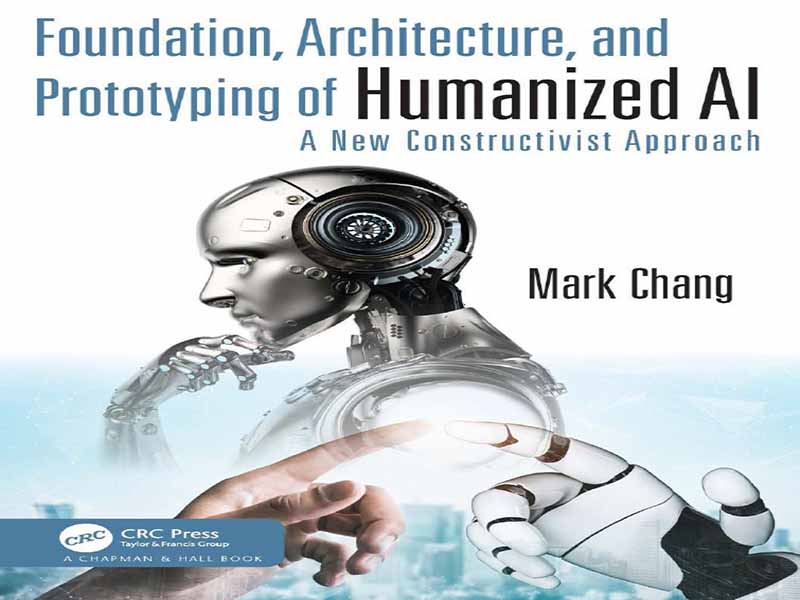- عنوان کتاب: Foundation, Architecture, and Prototyping of Humanized AI A New Constructivist Approach
- نویسنده: Mark Chang
- حوزه: کاربرد هوش مصنوعی
- سال انتشار: 2023
- تعداد صفحه: 385
- زبان اصلی: انگلیسی
- نوع فایل: pdf
- حجم فایل: 5.15 مگابایت
هوش مصنوعی انسانیشده (HAI) عبارتی است که برای اشاره به موجودات اجتماعی مصنوعی استفاده میشود که از جنبههای مختلف نمایش داده شده بسیار شبیه به انسان هستند. این جنبهها ممکن است شامل توانایی یادگیری، کشف دانش، حل مسئله، خلاقیت، احساسات ارتباطی، خودآگاهی و هوشیاری باشد. به یک معنا، هوش مصنوعی، مصنوعیسازی انسانها است، در حالی که HAI، انسانیسازی مجدد انسانهای مصنوعیشده است. HAI را میتوان به عنوان هوش مصنوعی در سطح انسان یا هوش عمومی مصنوعی در نظر گرفت، اما بر ویژگیهای انسانمانند نیز تأکید دارد. عاملهای HAI، انسانهای نژاد ماشینی هستند، نه بردههای دیجیتال. مشاهده شده است که اصطلاح «هوش مصنوعی انسانیشده» ممکن است توسط افراد مختلف در زمینههای مختلف یا به معنای محدود استفاده شود. این کتاب در مورد چگونگی ساخت عاملهای HAI است که به عنوان موج بعدی هوش مصنوعی ظاهر میشوند. این کتاب مباحث فلسفی در مورد مباحث اصلی HAI، معماریهای HAI و عاملهای HAI نمونه اولیه را پوشش میدهد. این عاملها عملاً عاملهای مبتنی بر داده صفر (Zda) و عاملهای مستقل از زبان (Lia) هستند که زبانهای طبیعی داخلی ندارند. هر دو قادر به نمایش مهارتهای یادگیری عالی، خودآگاهی، هوشیاری و هوش هیجانی هستند. برخلاف هوش مصنوعی محدود، که در آن هر عامل فقط میتواند یک مهارت خاص داشته باشد، تحمل پیچیدگی HAI به یک عامل انسانیشده این امکان را میدهد که مهارتهای مختلف زیادی را در طول زمان بدون شروع مجدد یا پاک کردن اطلاعات قبلی یاد بگیرد. من کار روی HIA را در سال ۲۰۰۳، حدود ۲۰ سال پیش، زمانی که برای اولین بار به یک واقعیت ساده پی بردم، شروع کردم: یک نوزاد انسان عملاً مغزی خالی از داده دارد و هیچ زبان طبیعی ارثی ندارد، اما میتواند چیزهایی مانند زبانها و مهارتهای ریاضی را یاد بگیرد. من بلافاصله یک نسخه بسیار ساده از HAI را با استفاده از مایکروسافت ویژوال بیسیک نمونهسازی کردم. همانطور که انتظار داشتم، عاملها میتوانند از طریق تعاملات با استفاده از یادگیری تقویتی، «زبان» بسیار سادهای را یاد بگیرند و ایجاد کنند. این رویکرد همان چیزی است که اکنون رویکرد سازندهگرایی نامیده میشود. با این حال، کمی پس از آن با یک چالش روبرو شدم: وقتی مفاهیم پیچیدهای مطرح میشوند، یادگیری تقویتی سنتی مسیرهای زیادی برای بررسی دارد تا اینکه عامل بتواند یک راهحل بهینه یا معقول را شناسایی کند. من ۱۵ سال بعد برای حل این مشکل تلاش کردم تا اینکه سرانجام در سال ۲۰۱۶ به رویکرد سنتزگرای فعلی رسیدم که ترکیبی از کارایی رفتارگرایان و انعطافپذیری سازندهگرایان است. رفتارگرایان معتقدند که اعمال، بازتابی از آنچه در ذهن میگذرد هستند و رویکردی هدفمحور را اتخاذ میکنند. سازندهگرایان تأکید میکنند که دانش نمیتواند بازتابی منفعل از واقعیت باشد، بلکه ساختاری فعال توسط فرد، از ساده به پیچیده است. ما با ترکیب این دو در معماری HAI خود، یک رویکرد ترکیبی را اتخاذ میکنیم – یک رویکرد سازندهگرایانه جدید. در این رویکرد، به جای تأکید بر این مفهوم که عمل یک عامل مبتنی بر حداکثرسازی نوعی سودمندی است، همانطور که خردگرایان انجام میدهند، ما به صورت احتمالی یک حداکثرسازی تصادفی را برای شبیهسازی بهتر تفکر و رفتارهای انسانی اتخاذ میکنیم. معماری HAI چهار مؤلفه اصلی دارد. (1) یک شبکه بازگشتی از الگوها، برای نمایش پویای دانش، یک ساختار خود-فراگیر لازم برای خودآگاهی را فراهم میکند. (2) مکانیسمهای توجه به یک عامل HAI اجازه میدهند تا برای یادگیری و پاسخ کارآمد، روی چند چیز مهم تمرکز کند. (3) مکانیسمهای یادگیری که دارای توکنسازی سلسله مراتبی و الگوسازی بازگشتی هستند، امکان یادگیری تدریجی، از ساده به پیچیده را فراهم میکنند. (4) مکانیسمهای پاسخ تقویت تطبیقی، با تقلید از اراده آزاد، پاسخهای بالقوه را بر اساس پاداشها یا فراوانیهای مرتبط تصادفی میکنند. یکی از ویژگیهای اصلی یا هدف HAI این است که تقلید، انجام کاری که افراد دیگر در موقعیتهای مختلف انجام میدهند، باعث میشود عوامل HAI بدون تعیین قبلی هیچ یک از هنجارها، به هنجارهای اجتماعی پایبند باشند. رویکرد HAI ما بر اساس چندین اصل و قانون کلی، از جمله اصل شباهت، اصل صرفهجویی، اصول انجمنی، اصول اولیه، اصل جداسازی عامل، قانون اثرات تجمعی و قوانین وبر-فکنر ساخته شده است. این اصول، تمام روشها یا مکانیسمهای خاص در معماری HAI را منسجم میکنند. اصل شباهت، که در مکانیسمهای یادگیری و پاسخ استفاده میشود، کلید مقابله با نوآوریهایی است که عوامل HAI در الگوسازی یا کشف علمی با آن مواجه میشوند. دلیل این امر این است که همه چیز در حال تغییر است و هیچ دو چیزی یکسان نیستند. این اصل ادعا میکند که دو شیء مشابه رفتار مشابهی دارند، بنابراین به ما و عوامل اجازه میدهد چیزهای مشابه را در دستهها گروهبندی کنیم و الگوها را بسازیم. اصل شباهت با تقلید و خلاقیت زیر یک چتر واحد سروکار دارد، یعنی در جایگزینی مشابه بلوکهای سازنده جهان با درجات مختلف شباهت. اصل ارتباط، ارتباط بین دو چیزی را که از نظر مکانی یا زمانی نزدیک هستند تضمین میکند و به عنوان ستون فقرات یادگیری عمل میکند. اصل ارتباط به یک عامل اجازه میدهد تا الگوهای زبان طبیعی را به الگوهای رویدادهای محیطی نگاشت کند. از این نظر، HAI را میتوان به عنوان یک برنامه کامپیوتری در نظر گرفت که به طور خودکار برنامههای کامپیوتری تولید میکند. چیزی که به نظر میرسد یک جهان پیچیده است.
Humanized AI (HAI) is a phrase used to denote artificial social beings that are very close to humans in various displayed aspects. These may include learning ability, knowledge discovery, problem-solving, creativity, communicated emotion, self-awareness, and consciousness. In a sense, AI is the artificialization of humans, while HAI is a re- humanization of artificialized humans. HAI may be considered as human-level AI or artificial general intelligence, but it also emphasizes human-like features. HAI agents are machine-race human beings, not digital slaves. It is noticed that the term “Humanized AI” might be used in a different context or a narrow sense by different people. This book is about how to make HAI agents which come as the next AI wave. It covers philosophical discussions on central topics in HAI, the architectures of HAI, and prototypical HAI agents. The agents are virtually Zero-data based agents (Zda) and Languageindependent agents (Lia), having no-built-in natural languages. Both are capable of displaying great learning skills, self-awareness, consciousness, and emotional intelligence. Unlike narrow AI, where each agent can only have a particular skill, the elaboration tolerance of HAI enables a humanized agent to learn many different skills over time without restarting or erasing previous information. I started to work on HIA in 2003, some 20 years ago, when I first realized a simple known fact: a human baby has virtually a data-empty brain and no inherited natural languages, but can learn things like languages and math skills. I immediately prototyped a very simple version of HAI using Microsoft Visual Basic. As I expected, the agents can learn and create very simple “language” through interactions by means of reinforcement learning. The approach is what is now called the Constructivist Approach. However, shortly thereafter I faced a challenge: when complex concepts are involved, traditional reinforcement learning has too many paths to explore before the agent can identify an optimal or reasonable solution. I struggled to solve the problem for the next 15 years until I finally came up with the current synthesist’s approach in 2016, which combines the behaviorist’s efficiency and constructivist’s flexibility. Behaviorists believe actions are reflections of what goes on in the mind, adopting a goaldriven approach. Constructivists emphasize that knowledge cannot be a passive reflection of reality, but an active construction by the individual, from simple to complex. We take a synthetic approach by combining the two in our HAI architecture—a new constructivist approach. In this approach, instead of emphasizing the notion that an agent’s action is based on the maximization of some utility as Rationalists do, we adopt probabilistically a randomized maximization to better emulate human-thinking and behaviors. The HAI architecture has four main components. (1) A Recursive Network of Patterns, for dynamic knowledge representation, provides a self-inclusive structure necessary for self- awareness. (2) Attention Mechanisms allow an HAI agent to focus on a few important things for efficient learning and response. (3) Learning Mechanisms that feature hierarchical tokenization and recursive patternization allow progressive learning, from simple to complex. (4) Adaptive Reinforcement Response Mechanisms, mimicking free will, randomize potential responses according to the associated rewards or frequencies. A major feature, or objective, of HAI is that imitation, doing what other people do under various situations, makes HAI agents adhere to social norms without pre-specifying any of the norms. Our HAI approach is constructed on several general principles and laws, including the Similarity Principle, Parsimony Principle, Association Principles, First Principles, Principle of Factor Isolation, Law of Summative Effects, and Weber-Fechner Laws. The principles make all specific methods or mechanisms in the HAI architecture coherent. The Similarity Principle, used in learning and response mechanisms, is the key to dealing with novelties encountered by HAI agents in patternization or scientific discovery. This is because everything is changing, and no two things are identical. This principle asserts that two similar objects behave similarly, thus allowing us and agents to group similar things into categories and make patterns. The Similarity Principle deals with imitation and creativity under the same umbrella, i.e., in similarity replacement of the building blocks of the world with different degrees of similarity. The Association Principle guarantees the association between two things that are spatially or temporally close, and it serves as the backbone for learning. The Association Principle allows an agent to map natural language patterns to environmental eventpatterns. In this sense, HAI can be considered as a computer program that automatically generates computer programs. What appears to be a complex universe can actually be modeled by a recursion of a simple world governed by a small set of principles. Enlightened by First Principles and Connotation of understanding, we postulate that any complex concept or knowledge consists of a hierarchical recursion of elementary concepts and any high-level skill is a composition of sequential and recursion of elementary movements of body parts. These atomic concepts and movements, despite varying from individual to individual, are the building blocks of our HAI agents—they make it possible to build HAI using a small-data approach! The Weber-Fechner Laws serve the basis for building virtual sensory organs, the Parsimony Principle supports the adaptive reinforcement learning in response model, the Law of Summative Effects ensures that the sequence of short-term goal-driven actions will achieve a long-term goal, and the Principle of Factor Isolation guides experience-based learning (patternization) and cognitive learning (logical reasoning). Given the complexity of HAI, studying HAI without discussions of architecture and prototyping to show how it works will be somewhat empty and less convincing, while studying HAI architecture and prototyping without understanding the fundamental issues and human characteristics is a mindless approach that will not lead too far either. Thus, I have an ambitious goal: to cover vertically the whole spectrum from foundation, architecture, and prototyping (algorithm and pseudocode) in a concise book. Keep in mind that even if (or when) we make the first agent exactly like a human baby, it will take 10–20 years to teach him what he needs to thrive. Principles and methods of teaching HAI agents are also a critical topic for our discussion. The book has four parts and an appendix. Part I features philosophical discussions of some key aspects of HAI, such as consciousness, the connotation of understanding, roles of attention, imitation, analogy and creativity, and scientific principles. Part II reviews the AI waves, existing approaches to HAI, and the new synthesist’s approach. These two chapters constitute the foundation for the HAI Architecture in Part III, which elaborates the architectures of the new constructivist approach, including innate knowledge, knowledge dynamic representation, learning mechanisms, response mechanisms, and effective teaching. Following the architecture blueprint, Part IV discusses prototyping the animated agents, Zda and Lia, with examples to show how language can be learned from scratch, how agents can learn playing board games starting from learning the rules, and many more. To make the book stand alone, The Appendix provides a concise review of narrow AI with emphasis on the ideas behind each method. This book is intended for anyone who is interested in HAI, including college professors, researchers, and students in Computer and Information Science, Computer Engineering, Data Science, Philosophy, Psychology, Education, Economics, and Political Science. The first two parts are geared toward the general audience, while Parts III and IV are more suitable for those who want to know exactly how HAI can be built to have human characteristics such as understanding natural language, self-awareness, consciousness, imitation, creativity, discovery, reasoning, goal-setting, and ethics. If you finish all four parts, you are expected to be able to use the computer language you are familiar with to translate the algorithms and pseudocode in Part IV into actionable agents, and to start to “raise” and teach your baby agents.
این کتاب را میتوانید از لینک زیر بصورت رایگان دانلود کنید:
Download: Foundation, Architecture, and Prototyping of Humanized AI A New Constructivist Approach



































نظرات کاربران